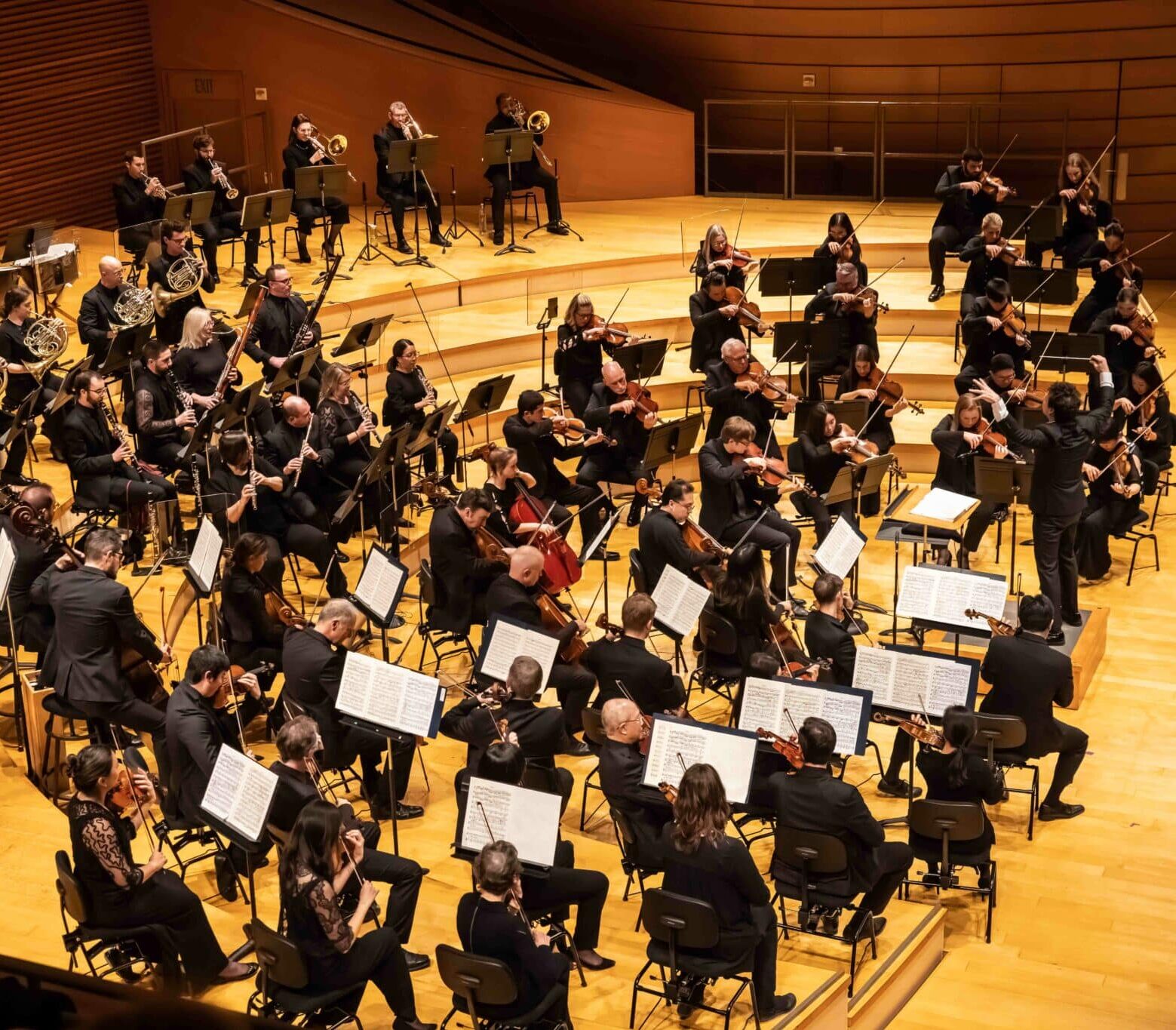Frequently Asked Questions
Get to know your Kansas City Symphony.
When planning your visit to the Kansas City Symphony, take a look at our frequently asked questions.
Have a question you don’t see here? Contact us.
Musicians in the Kansas City Symphony are selected in national auditions where often over 100 candidates compete for a single vacancy. Those selected are experienced, highly talented performers who are graduates of the nation’s finest music schools and conservatories. By the time a player is competitive for a position in the Kansas City Symphony, he or she likely has many years of training as a musician.
The string instrument bows for each section move in unison to bring continuity to the interpretation of the music. Principal string players mark “bowings” into the printed music for each work on the program, and our music librarians transfer those markings into the music for each player. These bowings may be modified by the conductor depending upon the particular interpretation he is seeking.
Some of our percussion instruments use calf-skin for the playing surface because of the superior sound and response. But these organic components are very subject to the temperature and humidity on stage – another reason we are delighted to be in the climate controlled Helzberg Hall.
Oboe reeds are made by hand and are unique to each player. Our oboe players spend hours each week making, testing, and shaping reeds to get just the right sound for each work on the program. Out of dozens that are made, only a few are selected for performance.
The Tuba like you see on our stage would be 16 feet long if it were uncoiled. The smallest wind instrument is the piccolo, which is about 11 inches long. There is also a Piccolo trumpet which is one half the length of the standard trumpet and is one octave higher, just as the piccolo is one octave higher than the standard flute. Who was the first major composer to use the piccolo in the orchestra? Beethoven.
The string instruments you see on stage are owned by our musicians and are the result of years of searching for just the right instrument and sound. Some are older than others, but some KCS musicians own instruments that are as much an investment as their homes. In addition to the instrument itself, string players must also find the right bow to get the most from their instrument. The cost of the bow can also be another major investment.
Not really. All the words can be used interchangeably. In fact, in the early 20th century, the New York Philharmonic was officially named “The New York Philharmonic Symphony Orchestra” so they had all bases covered. The word “orchestra” comes from the Greek and means “to dance” or “dancing place.” The word has its roots in Greek theatre, being the area in front of the stage where the chorus sang and danced. The term was revived in seventeenth century France and used for the area in front of the stage where the instrumentalists sat. The term was later applied to the players themselves. A “Chamber Orchestra” is the term used to describe a smaller orchestra, usually one that might perform works from the Baroque and early Classical period.
We hate to have “rules” about how you express your appreciation for our music making, but here is the simple answer – it is ALWAYS appropriate and encouraged to clap vigorously at the end of the composition. Some compositions, however, are in sections (also called “movements”). For example, Beethoven’s “Emperor” concerto is in three movements, and Respighi’s “Pines of Rome” is in four movements (but they are all connected so that’s another story). To provide continuity, we generally do not clap between the movements because the complete work is not finished, but when the end finally comes – go for it!
Partly tradition, also because the oboe produces a clear, resonant tone that is easily heard by the entire orchestra, and because historically the oboe was more subject to environmental influences and it was easier to tune the orchestra to it than vice versa. Today, oboists (and other instrumentalists) use electronic tuners to check their pitch as well. When there is a piano concerto on the program, the concertmaster sounds the “A” from the piano, and the orchestra tunes to that pitch.
Absolutely not. All that is required is the ability to appreciate and enjoy beauty. One of the hallmarks of a truly great work of art is that it appeals to both the novice and the connoisseur, so there is no pre-requisite to enjoy great music. If you want to know more about the music, you can read program notes about the music online ahead of the concert, and you can also attend our pre-concert lectures “Concert Comments,” which are casual, very informal discussions about the music held in the hall one hour before the concert.
The Kansas City Symphony Chorus is comprised of 150 talented singers, who are volunteers selected by audition especially to perform in choral performances with the Kansas City Symphony.
